You might not look into fish food dispensers until you’re planning a trip out of town, but the truth is that these devices are handy for a lot more than just vacation feedings. What are the perks of having an electric feeder for your tank, and what features should you look for? Check out our reviews for the best automatic fish feeders and see how much easier they can make your aquarium care!
Quick Comparisons of the 5 Best Automatic Fish Feeders
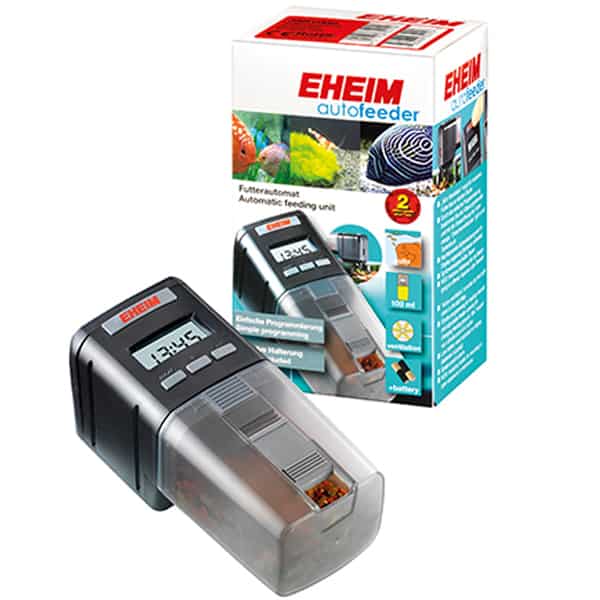
BRAND
Eheim Everyday Feeder
DETAILS
- Type of Feeder: Barrel
- Dimensions: 2.5 x 2.5 x 5.5 inches
- Power Source: Battery
- Capacity: 100 ml
- Types of food: Flake or pellet
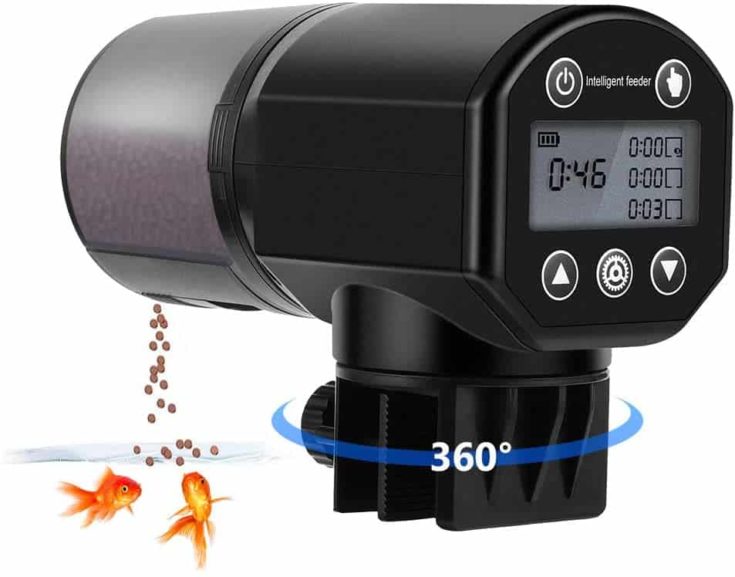
Barkmew Moisture-Proof Dispenser
- Type of Feeder: Barrel
- Dimensions: 5.91 x 2.76 x 4.72 inches
- Power Source: Battery
- Capacity: 200 ml
- Types of food: Flake, pellets, powder and bar
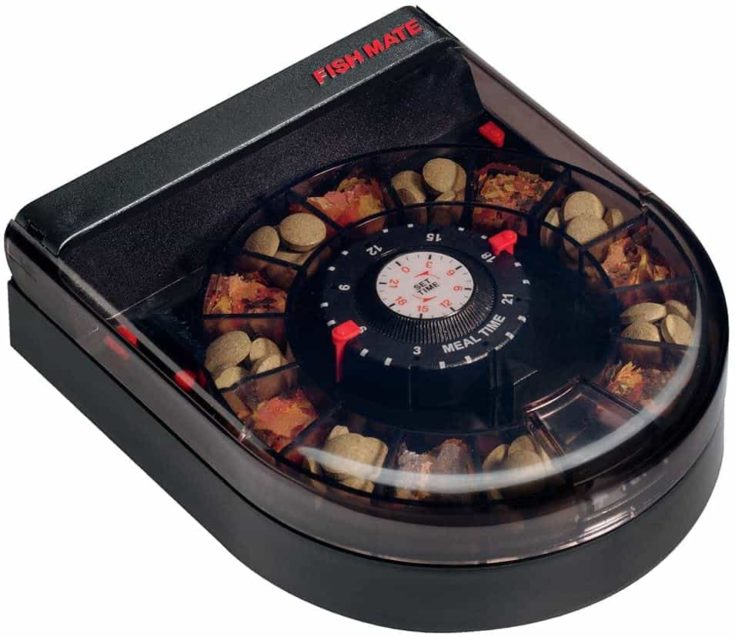
Fish Mate F14 Aquarium Feeder
- Type of Feeder: Portion Control
- Dimensions: 4.65 x 5.47 x 1.54 inches
- Power Source: Battery
- Capacity: 14 food slots
- Types of food: All
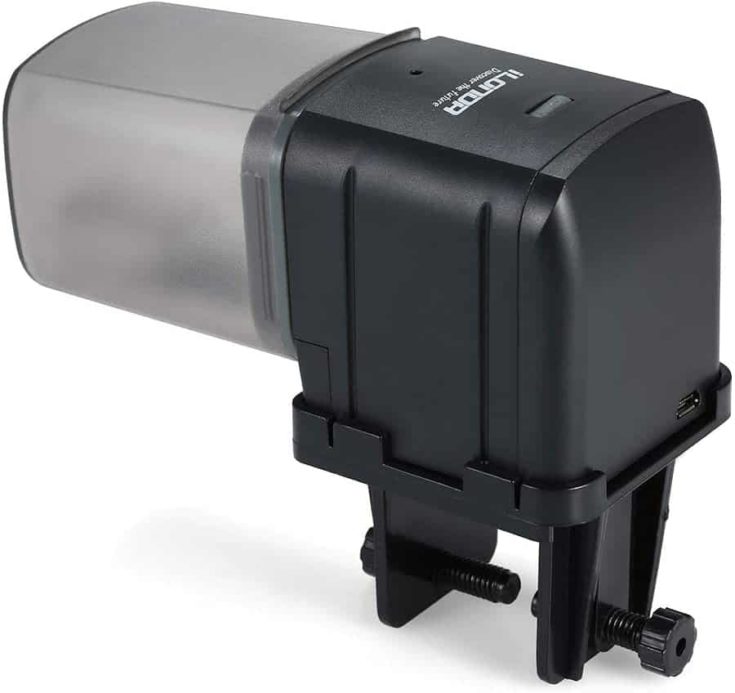
Decdeal Adjustable Food Dispenser
- Type of Feeder: Barrel
- Dimensions: 8.03 x 2.95 x 2.91 inches
- Power Source: USB/Electrical
- Capacity: 160-170 ml
- Types of food: Flake, pellet or granules
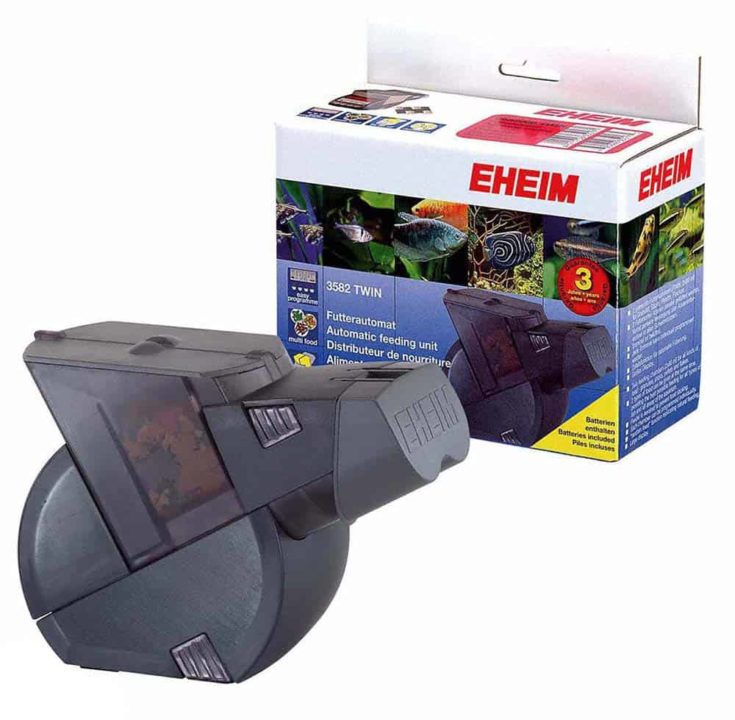
Eheim Twin Battery Powered Feeder
- Type of Feeder: Barrel (double)
- Dimensions: 6.34 x 2.91 x 4.65 inches
- Power Source: Battery
- Capacity: 60 ml per barrel (120 ml total)
- Types of food: Flake, pellet, stick, tablet
Do You Need an Automatic Fish Feeder?
I’ll be the first to admit that an automatic fish tank feeder can seem like a luxury purchase, but the truth is these little devices are inexpensive, quite handy, and may even be necessary for some types of aquatic communities. In fact, they’re often just as useful for day-to-day care as they are for covering your weekend trips!
Who Can Benefit from Using an Automatic Feeder?
Electric fish feeders are the ideal way to ensure that every member of your aquatic community gets fed the right food at the right time, whether you’re home or not. Most aquarium experts recommend feeding several meals a day rather than one big one, but that can be really challenging if you have a busy or erratic schedule:
- While most mature fish can miss a few meals without any harm, that’s not the case for young animals or those being conditioned for breeding, or for the delicate marine invertebrates like anemones and corals.
- Feeding your tank on a reliable and set schedule also makes it easier to manage your monthly aquarium maintenance, since the build-up of toxins and gunk in your filter is more predictable than in a tank that’s fed erratically.
- Random feeding schedules can also be an issue for communities with a mix of diurnal (daytime) and nocturnal (nighttime) creatures. If you feed your tank in the early afternoon, for instance, there may not be anything left when your nocturnal loaches and catfish are naturally looking for a meal.
Vacation fish feeders are also very useful for busy families, students, people who work odd hours or graveyard shifts, and anyone who wants to regularize their tank’s feeding schedule. A feeder may be an indispensable tool if you have an office aquarium to care for or have invested thousands in a big reef tank!
What is an Automatic Fish Feeder and How Do They Work?
Auto feeders save you time (and money) by adding measured portions of food to your tank on a set schedule. That way, the food is quickly consumed by your community and there’s no scraps left to foul the water or your filtration system. You also won’t need to pay a sitter to feed your tank every day while you’re on vacation!
- An auto feeder allows you to control the number, size and timing of the meals in your tank.
- Electric feeders usually sit on the top or attach to the side of your tank and have a central chamber you fill with a commercial food, like a fish flake or pellet diet.
- When the timer goes off, the dispenser’s door opens and drops a portion of the food into your tank, usually through an opening on your lid or cover. You can also use these devices with a feeding station or ring.
Disadvantages of Auto Feeders
Handy as they are, fish feeders aren’t ideal for every situation, and they come with some definite drawbacks as well. Before you invest in a system for your tank or pond, let’s talk about the disadvantages of using an automatic feeder:
Limited Types of Diets
The biggest drawback is that electric feeders don’t work with every type of commercial diet, and many are limited to only dispensing flaked or pelleted foods. They’re useless for feeding live or frozen foods, and often can’t handle odd-sized foods like algae wafers or dried shrimp.
The other limitation is that most feeders can only hold and dispense a single type of food, which may not work for more diverse communities. You may have to buy multiple feeders if your community needs a mixture of diets, such as floating flakes for your schooling fish and sinking pellets for your bottom feeders and corals.
Appearance
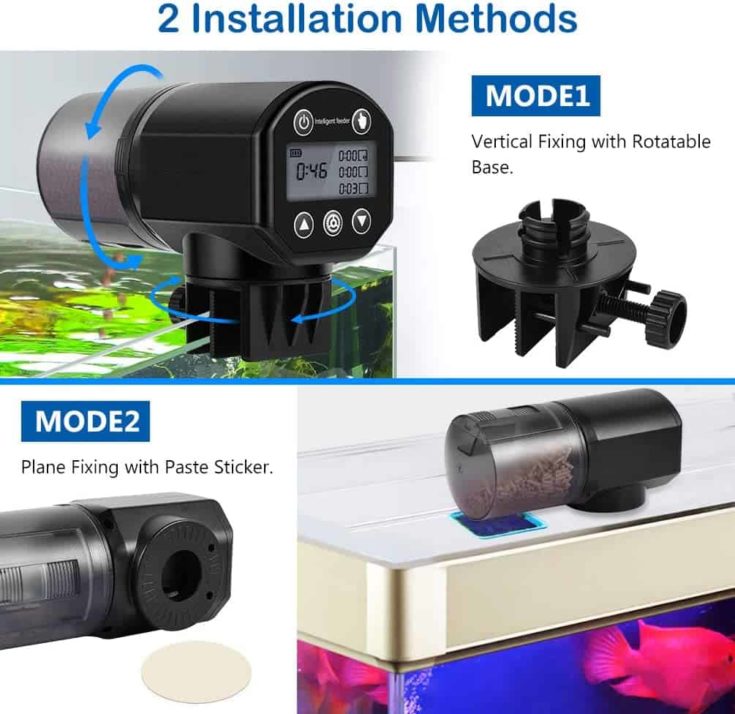
Feeders typically sit on or get mounted to the top of your tank, and that means they aren’t usually hidden away in a discreet spot. You may not care for the appearance of a feeder poking out the top of your tank, especially if you’ve spent a lot of money on a custom aquarium.
They Don’t Always Work
Another drawback to relying on an auto feeder is that they don’t always work as intended. If the feeder breaks or the batteries die while you’re out of town, your fish may not eat for weeks! If the food is exposed to moisture, it can clump together and even block the feeder’s door, preventing or reducing the amount of food dispensed.
Amount of Food Dispensed Per Meal May Vary
The final issue with auto feeders is that they may not dispense the precise amount of food you want each time, especially if you’re using diets that aren’t uniform in size (most flaked foods). These variations in meal sizes aren’t usually an issue for larger communities, but can lead to potentially dangerous overfeeding in a small one.
Types of Automatic Feeders
What type of feeder should you get for your tank? While you can always go the DIY route or even use a vibrating pager or cell phone to shake a portion of food into your tank, the primary types of feeder you’ll see for sale are either the barrel-style or portion control feeders.
Rotating Barrel Fish Feeders
The vast majority of products on the market are rotating barrel fish feeders. Barrel feeders have a central hopper for food that rotates and funnels portions to an opening that sits over the top of your tank. When the timer goes off, a door slides open and allows the food to fall into the aquarium.
Barrel feeders are a popular choice for several reasons:
- They can hold more than a portion control feeder, which makes them a better option for large communities or for extended trips.
- They are more flexible in their operations and can be programmed for multiple meals a day, and many can also dispense double or even triple-sized portions.
- There’s a wide variety of brands and models available, and lots of information online about how to modify these feeders to fix any performance issues.
There are downsides to using barrel feeders, however:
- They can only be filled with one type of food at a time, so you may need multiple feeders.
- They only work with a few types of food (varies by model) and can’t dispense bulky or awkwardly shaped diets like flat algae wafers or giant dried shrimp.
- Their performance isn’t uniform from diet to diet, either. They usually work best with pelleted diets, and even those that do work for flaked or powdered foods often suffer from problems with clumping or fluctuations in their portion control.
- They can’t reliably dispense very small portions and might accidentally overfeed your betta or goldfish, so they’re a better option for bigger communities rather than nano set-ups.
- They require regular (monthly to bi-monthly) maintenance to prevent food particles from clumping up inside the hopper, which can affect its performance.
Portion Control Fish Feeders
Portion control feeders look like an automatic cat feeder in miniature. This style has a rotating base with slots for each meal that you fill yourself. When the timer goes off, the food is pushed out of the slot into the top of your tank. These feeders can dispense an exact portion of food or even mix of foods!
There’s several benefits to using a portion control feeder:
- Unlike barrel feeders, portion control feeders work with nearly all types of commercial diets and can dispense multiple types of food in each meal. You can fill the slots with a mix of flakes, pellets, bars, powders or even oddly-shaped wafers!
- They are very precise, since each meal slot is hand-filled with the exact amount of food or mix of foods you desire, which makes them ideal for feeding diverse communities and very small tanks.
But there’s drawbacks to portion control feeders as well:
- They have much less capacity than barrel feeders, since most models can only hold a maximum of 14 meals at a time.
- The slots are not very large and can’t hold a lot of food, so these feeders are often inadequate for large aquariums. You may also need to break up large wafers or dried foods to fit them into the dispensing slots.
- Their programming options are limited and less flexible as well, and it may be tricky to skip meals or auto-fast your community.
- These feeders require more effort on your part, since you’ll need to measure out meals and fill the slots at least every 14 days.
There’s only a few models and brands available.
Fish Feeder Style
Rotating Barrel Feeder
Ideal for extended trips, feeding medium to large populations, and both aquarium and pond communities
Pros
Large holding capacity
Flexible programming allows for multiple meals and portion sizes
Wide variety of models and brands available
Cons
Can only dispense one type of food at a time
Works with a limited number of diets
Performance is usually better with pellets vs flakes
Can’t accurately dispense very small portions
Require regular maintenance
Fish Feeder Style
Portion Control Feeder
Ideal for short trips, diverse communities that need multiple types of food and tanks with small populations
Pros
Works with most types of commercial diets
Can dispense multiple types of food per meal
Very precise and can easily dispense small portions
Cons
Capacity is limited by the number and size of the meal slots
Programming options are a lot more limited
Requires more work to measure food and hand-fill meal slots
Only a few brands and models available
How to Choose an Automatic Feeder: Features to Consider
Once you’ve picked out the style of feeder you’re interested in, how can you select the best brand and model for your needs?
Power Source and Low Power Alerts
Electric feeders are usually powered by batteries, although some plug directly into your power outlets. The newer feeders often use USB cables, but for the majority you’ll just swap out the old batteries with new ones when they run low. In most cases, though, you can’t use conventional rechargeable batteries in an auto feeder and have to use the disposable kind. You should definitely look for a feeder with a low power alert!
Capacity
How much food can your feeder hold, and how often will you have to refill it? The advantage of using portion control feeders and small capacity barrel feeders is that they usually have fewer problems with food clumping, especially for flaked and powdered diets. But that means you’ll also have to refill them more frequently.
Portion Size and Number of Meals
Auto feeders vary in the maximum number of meals they can dispense each day and some can also dispense double or triple portions for feeding large communities. Since there’s so much variation, it’s hard to predict in advance how much time you’ll have between refills until you’re actually using a feeder, however.
Manual Feeding Bypass
One of the features you’ll probably be glad to have is the option to feed your fish on command! With a manual bypass button, you can dispense a food treat or meal into your tank without having to drop it in yourself.
Ventilation and Fans
Many feeders have a fan and/or ventilation slots to regulate the temperature and reduce the moisture inside the feeder’s chamber. Since they usually sit on top (close to light fixtures and filters), they’re exposed to evaporation and temperature fluctuations that can trap water inside the hopper, causing the food to stick together and clump. Fans may help prevent these problems, but most of the time they only run while the feeder is dispensing food. They’re useful, but not critical to have.
Ease of Use
Auto feeders vary widely in their ease of use, and some are a lot harder to program and operate than others. Premium models may have digital displays, while the analog types often resemble an old-fashioned light timer. I’d definitely prioritize getting a model that’s easy to use and adjust, but whether you go digital or old-school is a personal choice.
How to Set-Up and Get The Most From Your Automatic Feeder
Here’s a few tips for setting up an auto feeder and getting the most out of your new piece of aquarium equipment!
Feeder’s Location
The majority of feeders are designed to sit on top of your aquarium’s lid, so you may need to cut an opening or modify the cover so the food falls in the right spot.
- If you can, try to avoid placing the feeder close to your light fixture, since the heat can degrade the quality of the food and cause problems with water condensation inside.
- It’s best to avoid placing your feeder too close to your filtration or aeration systems, since that exposes it to evaporating water and increases the moisture inside the chamber, which can lead to food clumping.
- Some folks arrange their feeders to dispense near their filter’s outtake vent, since that can help distribute the meal throughout the entire tank. But avoid dispensing food near the intake, and consider using a feeding station or ring to prevent the food from being sucked into your filter.
Attaching or Mounting the Feeder
Most feeders have at least a couple of options when it comes to their placement on your tank, and can either sit on the top cover or be mounted to the rim or side. If you’re worried about the appearance, look for feeders with a side mount or low-profile option instead of one that sits on the top!
Testing Before You Leave Town
I highly recommend testing your feeder for a few weeks to a month before you risk taking an extended trip out of town, since that will give you plenty of time to become familiar with its operation and quirks. Another option is to set up a webcam and monitor your aquarium and feeder remotely, as long as you have someone nearby who could pop in to fix any problems you might discover.
Top 5 Automatic Fish Feeders for Aquariums: Product Reviews
If you’re looking for an aquarium fish feeder, then check out our reviews for these 5 highly rated and popular models! There’s an auto feeder on our list suitable for nearly any type of aquatic community, from a betta set-up to a saltwater reef tank.
1. Eheim Everyday Feeder

- Type of Feeder: Barrel
- Dimensions: 2.5 x 2.5 x 5.5 inches
- Power Source: Battery
- Capacity: 100 ml
- Types of food: Flake or pellet
It’s no surprise that the Everyday Feeder from Eheim is still one of the most popular on the market, even though the design hasn’t changed much over the last decade. If you want a reliable and feature-rich barrel feeder, this could be the best pick for your tank. It can be programmed to dispense up to four meals or double-portioned meals a day, works with either fish flakes or pellets, and it doesn’t even have to be mounted to your tank with the optional bracket and can sit right on top.
The Eheim Everyday also allows for manual feedings and is ideal for mid-sized to large communities, although you can also modify the dispensing window to reduce the meal sizes further. It can be mounted to the rim of any tank up to ¾-inch in width, and has an aerated chamber to reduce food clumping.
PROS
- Easy to set-up and use, and comes with an optional mounting bracket to secure it to the top of your tank.
- Has a low battery alert, manual feeding bypass and integrated ventilation system.
- Can feed up to 4 meals a day and offers single and double portions.
CONS
- Limited in the types of food, since it can only handle flake and pellet diets.
- Unable to dispense very small quantities of food without additional DIY modifications.
- Even with the ventilation and fans, food in the chamber tends to pick up moisture.
2. Barkmew Moisture-Proof Dispenser

- Type of Feeder: Barrel
- Dimensions: 5.91 x 2.76 x 4.72 inches
- Power Source: Battery
- Capacity: 200 ml
- Types of food: Flake, pellets, powder and bar
If you want a feeder with the biggest capacity you can find, then the Barkmew Moisture-Proof Dispenser could be the pick for you! This feeder holds twice the amount of food of the Eheim Everyday and has a large door for easy refilling. This is also a versatile feeder, since it works with flake, pellet, bar and powdered foods. It’s easy to program and can be mounted to the top with the included bracket or on the side of your tank with a strong sticker.
You can offer your community up to three meals a day in single, double or triple portions, although it doesn’t dispense small portions very reliably without some DIY mods. This is an excellent option for a fresh or saltwater fish feeder, and would work for an aquatic turtle tank as well!
PROS
- Extra-large capacity holds up to twice the amount of food and works with fish flakes, pellets, bars and powders.
- Digital screen and easy programming allows it to dispense up to 3 meals a day in single, double or triple portions.
- One of the easiest to refill, this feeder swivels on its base and has a top hatch for pouring food in!
CONS
- Doesn’t have a low battery alert and must be mounted to the tank to work.
- Can’t easily dispense very small quantities without modification, so not ideal for small or solo-fish set-ups.
- Moisture in the chamber can lead to problems with food clumping, so not always reliable without regular maintenance.
3. Fish Mate F14 Aquarium Feeder

- Type of Feeder: Portion Control
- Dimensions: 4.65 x 5.47 x 1.54 inches
- Power Source: Battery
- Capacity: 14 food slots
- Types of food: All
If you’re looking for an automatic fish feeder for small tanks or need a feeder that can dispense several types of food with each meal, then you should check out this portion-controlled F14 Feeder from Fish Mate. Modeled after their popular automatic feline feeders, the Fish Mate has 14 food slots and slowly dispenses each meal over the course of an hour. While it doesn’t have a digital display, the included pins allow you to dispense up to 8 meals a day, and you can even hook it up to an air pump to help keep the food dry.
The main drawback to this system is that it requires frequent refills; if feeding 8 meals a day, you’d only be able to use it for a little over 24 hours before it needed attention. But this is the best option if you need precision to prevent overfeeding in a single betta or goldfish set-up, or if you want a feeder that can dispense several types of food at the same time.
PROS
- Portion controlled feeder dispenses each meal gradually over an hour and is ideal for feeding small tanks, bettas and goldfish.
- Works with most commercial diets and can dispense a mixture of foods as well.
- Comes with a mounting bracket, but may also rest freely on the top if you prefer.
CONS
- Completely analog operation and uses pins to trigger the feeding timer.
- Length of time between refills will depend on how many meals fed each day, since it only has 14 slots for food.
- May need to break up large or oddly shaped foods to fit into the dispensing slots.
4. Decdeal Adjustable Food Dispenser

- Type of Feeder: Barrel
- Dimensions: 8.03 x 2.95 x 2.91 inches
- Power Source: USB/Electrical
- Capacity: 160-170 ml
- Types of food: Flake, pellet or granules
If you like to play with technology and want a feeder with the most up-to-date abilities, then this WiFi and voice-enabled feeder from Decdeal could be the one for you. It has a large capacity and can hold a bit more than the Eheim Everyday, and it works with flakes, pellets and even many granulated diets. It’s a little tricky to program, but once it’s set you can offer multiple daily meals and vary the portion size as you wish.
You can also control the unit remotely via a downloadable app on your smartphone or tablet, or use your existing Amazon Alexa or Echo to activate it. This isn’t the most reliable feeder and the additional technology means there’s a lot that can go wrong. I admit I’d be hesitant to use this feeder for an extended trip, but for everyday use, it’s a really interesting option.
PROS
- WiFi, voice and app-enabled feeder can be triggered remotely, and it’s compatible with Amazon Alexa and Echo.
- Works with most commercial flakes, pellets and granular diets.
- Multiple mounting options allow for it to be placed on top or on the side of your tank.
CONS
- No media trays.
- Not self-priming.
- Replacement parts can be pricey.
5. Eheim Twin Battery Powered Feeder

- Type of Feeder: Barrel (double)
- Dimensions: 6.34 x 2.91 x 4.65 inches
- Power Source: Battery
- Capacity: 60 ml per barrel (120 ml total)
- Types of food: Flake, pellet, stick, tablet
If you need a feeder that can dispense multiple types of food, then you have two options. You could buy a portion control feeder or several barrel feeders for your tank, or you could get the Twin Battery Powered Feeder from Eheim! The Twin has two separate barrels for fish food and dispenses the diets independently, so you can feed your schooling fish during the day and your bottom feeders at night if you want.
This programmable feeder has an LCD screen and each barrel can dispense up to three meals a day in single or double portions. Like the Eheim Everyday, the Twin has a manual feeding bypass, low battery alert and can either sit on or be mounted to your tank. Unlike the slightly limited Everyday, though, the Twin can dispense flake, pellet, stick or tablet foods, so it’ll work for nearly any aquatic community.
PROS
- Twin barrels can hold two different types of food and can dispense most flake, pellet, stick and tablet diets!
- Each barrel can dispense up to 3 meals a day and operate independently of each other
- Has an LCD screen, manual feeding bypass and random feeding settings
CONS
- Limited in capacity, as each barrel only holds about 60 mls of food
- While you can set it to fast your tank every 6th day, you can’t program it to skip meals otherwise
- It’s more complicated to set-up and operate than most and isn’t very user friendly
Conclusions
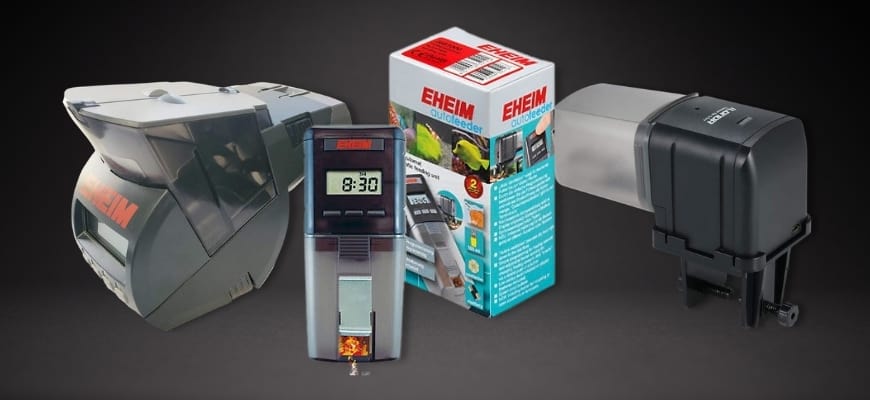
Don’t let a busy schedule keep you from starting a fish tank! Automatic fish feeders are more than a luxury item; they’re downright handy and most are inexpensive too. We hope you’ve found the perfect feeder for your tank on our list, but if you’re still not sure, here’s a few more bits of advice:
- The Everyday Feeder from Eheim is the overall best option for most aquarists, and has a time-tested design and reliable operations.
- If you require precision for feeding a small set-up like a betta tank, then the Fish Mate F14 is definitely the one to go with unless you feel like doing some research and playing with DIY mods.
- If you want to dispense two types of food, you can either get the slightly-complicated Eheim Twin or go with the portion-controlled Fish Mate!